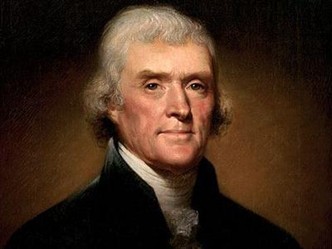In a letter to the governor of Virginia,
President Jefferson wrote: "However our present interests may
restrain us within our own limits, it is impossible not to look
forward to distant times, when our rapid multiplication will expand
itself beyond those limits and cover the whole northern, if not
southern continent, with a people speaking the same language,
governed in similar forms and by similar laws."
click here for more

Thomas Jefferson, a man who
never traveled more than 20 miles west of his home, Monticello, in
Virginia, was among the first to dream of moving the national
borders to the Pacific Ocean.
In part, the impetus to empire
and exploration came from the fact that no one really knew what was
out there, and no one was more curious than Thomas Jefferson.
It is sometimes said that Europe invented the Enlightenment and the
United States installed it on the Lockean tabula rasa of
the West. Like many of his ideas, Jefferson, the historical
figure, is a paradox. He had an expansive imagination but a
very limited knowledge of the West. He never travelled over
the Appalachian Mountains, so perhaps experiencing it in his
imagination set his mind free from the sobering considerations that
confronted the explorer. He was free to conceive of the
unimaginable in an open landscape, with nothing to loose and
everything to gain from his wanderings.
Jefferson may
have been intentionally crafty and evasive in public about the
Louisiana Purchase, but he intended for Lewis and Clark to make it
very clear to the tribes they met that they met along the way that
they were now residents of the United States and that the Great
White Fathers fully intended to control trade in the West. In
truth, Lewis and Clark were poorly prepared to negotiate the
complex political network of trade and blood-alliances that had
evolved on the plains over the course of many centuries. What
Lewis saw was the "unsteady movements and tottering fortunes" of
Indian people as measured through the eyes of someone shaped by the
gentrified upper class lifestyle of colonial Virginia, so it is not
an accident that the these first attempts to bring Indians into the
fold were generally unsuccessful.
To say
Americans discovered the southwest is presumptuous. When the
first American explorers set out in the nineteenth century from St.
Louis, bound for Santa Fe and Taos, they were venturing into a
region that had been the scene of extraordinary feats of discovery
by Spaniards for nearly three hundred years. Creaking and clanking
in their suits of metal, Spanish conquistadores and their
ferociously devout Jesuit missionaries had criss-crossed the region
from the Texas coast to the San Joaquin Valley and the coastal
plain of southern California. Garcia Lopez de Cardenas was
the first European to behold the Grand Canyon, almost three hundred
years before an American citizen would venture into its forbidding
canyons.
By 1776, American colonists
had barely ventured past the ridge back of the Appalachian
Mountains, but the Spanish knew about the seemingly endless
grasslands first traversed by Coronado two hundred years and fifty
years earlier. In 1809, based on information compiled
from the notes and journals of Spanish explorers, the great
naturalist Alexander Von Humbolt published his monumental map
entitled 'Map of New Spain,' detailing the southern coastline from
Florida to the Baja.
Click here for more
Related People
Related Events
Related Places